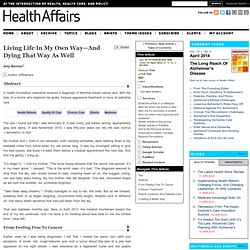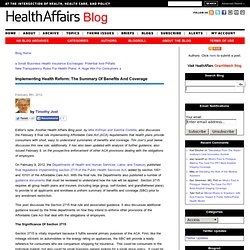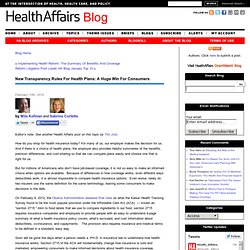

Living Life In My Own Way—And Dying That Way As Well. Amy Berman1 + Author Affiliations Abstract A health foundation executive receives a diagnosis of terminal breast cancer and, with the help of a doctor who respects her goals, forgoes aggressive treatment in favor of palliative care.

The day I found out that I was terminally ill, it was misty, just barely raining, appropriately gray and damp. It was November 2010; I was fifty-one years old. My mother and I, both in our raincoats, both carrying umbrellas, were walking down a city sidewalk miles from home when my cell phone rang. “It’s stage IV,” I told my mother. “Take three deep breaths,” I finally managed to say to her. That was eighteen months ago. From Feeling Fine To Cancer Earlier, even as I was being diagnosed, I felt fine. My primary care physician quickly arranged for me to have scans and a biopsy at a local hospital.
The night before my hospital appointment, I was wide awake, reading. When the biopsy results were back, I met with an oncologist in New York City, where I work. Why? Implementing Health Reform: The Summary Of Benefits And Coverage. Editor’s note: Another Health Affairs Blog post, by Mila Kofman and Sabrina Corlette, also discusses the February 9 final rule implementing Affordable Care Act (ACA) requirements that health plans provide consumers with short, easy to understand summaries of benefits and coverage.

Tim Jost’s post below discusses this new rule; additionally, it has also been updated with analysis of further guidance, also issued February 9, on the prospective enforcement of other ACA provisions dealing with the obligations of employers. On February 9, 2012, the Departments of Health and Human Services, Labor, and Treasury published final regulations implementing section 2715 of the Public Health Services Act, added by section 1001 and 10101 of the Affordable Care Act. With the final rule, the Departments also published a number of guidance documents that must be reviewed to understand how the rule will be applied.
This post discusses the Section 2715 final rule and associated guidance. Timing. Trusting Government: A Tale Of Two Federal Advisory Groups. Americans increasingly distrust what they perceive as poorly run and conflicted government.

Yet rarely can we see far enough inside the federal apparatus to examine what works and what doesn’t, or to inspect how good and bad decisions come to pass. Comparing the behaviors of two influential federal advisory bodies provides valuable lessons about how the mechanisms that drive government decisions can instill or diminish public trust. The Health Information Technology Policy Committee (HITPC) advises the Office of the National Coordinator for Health Information Technology (ONC) on matters pertaining to the ARRA/HITECH legislation. ONC is responsible for deciding how to spend the roughly $25 billion Congress authorized in 2009 to stimulate doctors’ and hospitals’ adoption of electronic health records (EHRs) and other health information technologies.
The Relative Value Scale Update Committee (RUC) is far more influential. Both HITPC and the RUC are comprised of volunteers. Email This Post. An intimate story about the American struggle with communication and preparation at the end-of-life.
Health Affairs. Mad as Hell. New Transparency Rules For Health Plans: A Huge Win For Consumers. Editor’s note: See another Health Affairs post on this topic by Tim Jost.

How do you shop for health insurance today? For many of us, our employer makes the decision for us. And if there is a choice of health plans, the employer also provides helpful summaries of the benefits, premium differences, and cost-sharing so that we can compare plans easily and choose one that is right for us. But for millions of Americans who don’t have job-based coverage, it is not so easy to make an informed choice when options are available. Because of differences in how coverage works, even different ways deductibles work, it is almost impossible to compare health insurance options. On February 9, 2012, the Obama Administration released final rules on what the Kaiser Health Tracking Survey found to be the most popular provision under the Affordable Care Act (ACA) — known as “section 2715.”
Soon will be gone the days when a person needs a PH.D. in insurance law to understand how health insurance works. National Association of Area Agencies on Aging.